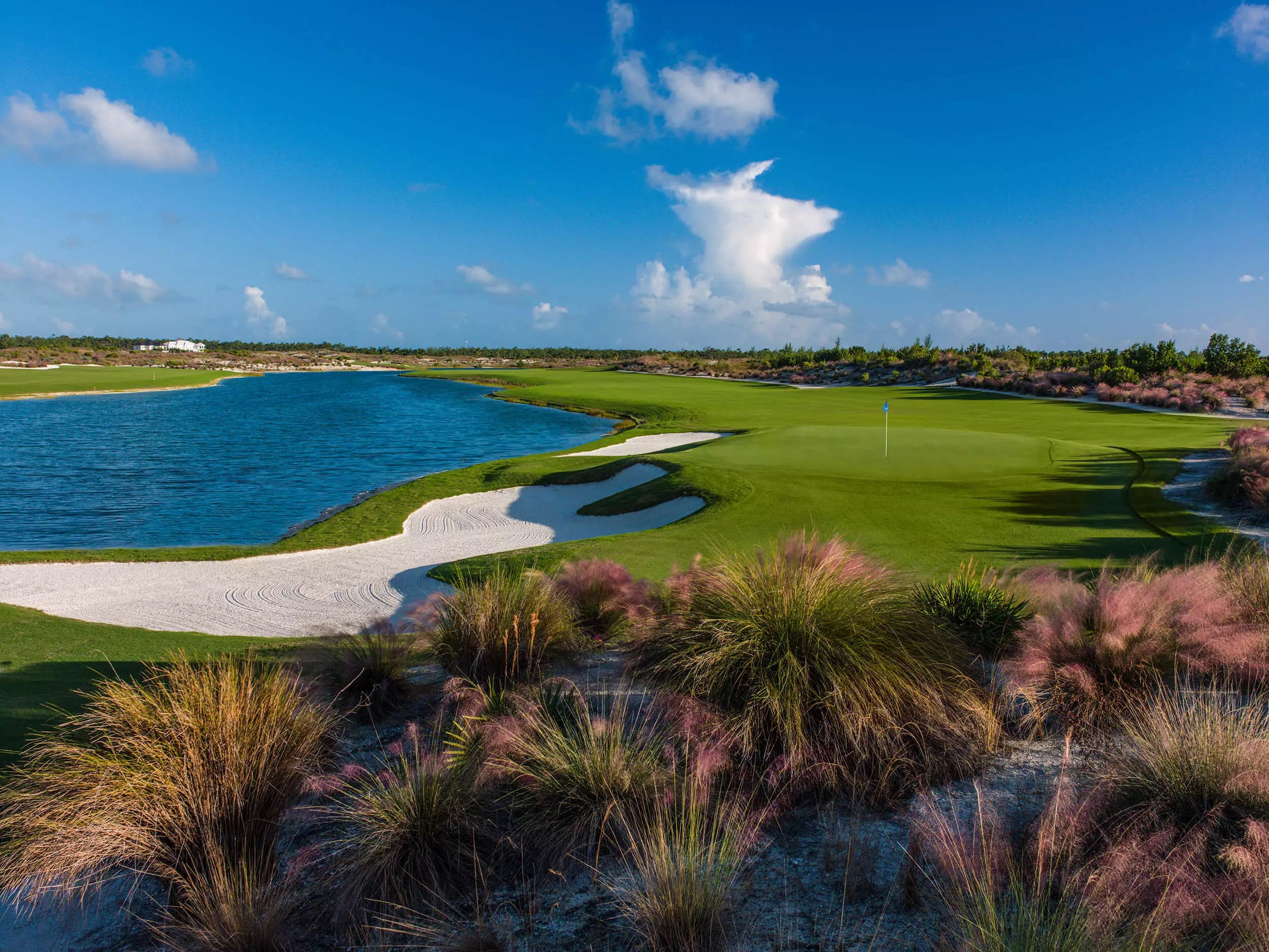
There are great invites in golf and then there are those envelopes that even the best players on the PGA Tour tear open on their way up their expansive driveways heading back to the house from the mailbox on the street.
An invitation to compete in the Hero World Challenge, to be played at Albany Golf Course in the Bahamas Dec. 1-4, is certainly one of the latter.
Nineteen of the best players in the world were invited to play in this unofficial PGA Tour event that’s hosted by Tiger Woods. It’s the seventh time the event will be played at Albany on the course designed by Ernie Els – who, along with Tiger, has a home in the exclusive community that surrounds the course.
Tiger won’t tee it up in 2021 due to injury, but proceeds from the 2022 Hero World Challenge still benefit the TGR Foundation, the Tavistock Foundation, and the Bahamas Youth Foundation.
The Bahamas are an idyllic archipelago rich in natural beauty and world-class golf courses set in stunning locations all just 150 miles from the east coast of Florida. The islands offer a tropical climate allowing year-round play, an unbeatable combination, especially in the winter months.
Part of the appeal of playing in the Hero World Challenge is the fellowship, a sense of knowing you are one of the alphas among the alphas that play on the PGA Tour. Then there’s the $3.5 million purse, with $1 million going to the winner and even the last-place finisher getting $100,000 for four days of “work.”

Els, Letsche made the most out of a rocky, flat site
Albany is set on the island of New Providence and is located only 10 minutes from Nassau’s international airport, which has direct service from all over North America as well as from London.
The course Els and associate Greg Letsche fashioned out of a difficult site also is a draw for the players. Opened in 2010, Albany Golf Course is a combination of links- and desert-style course features with plenty of scenic and strategically challenging water features.
It’s also a golf course that is very demanding. It gets windy as golfers are never more than a few miles from the Atlantic, but if you hit the right shots you can score. Success here is attained by managing the ever-present wind and staying in the playing corridors.
The 7,309-yard track is a par-72 and looks and plays like a course in Scottsdale as it winds through the Albany community. The fairway corridors are framed by man-made sand dunes and feature waste areas, desert-scrub vegetation, and big, white-sand bunkers. The routing features five par-5s and five par-3s, with mostly small greens and daunting closely mown runoff areas for shots that are not absolutely accurate.
As long as the golfer is in the fairway and in the mostly wide corridors that they center, lies are flat and the course is more than playable. The site for the course was very rocky but mostly flat, so Els’ team dug out rock to form the routing’s lakes and to use as a base for the dunes, some up to 30 feet in height, that were built to separate the holes.
The front nine weaves around more of Albany’s housing lots while the back nine is scenic and intriguing and best of the two sides. The par-3s on the course are favorites of the designer because they are among its “most links-like” holes.
No. 2, a 193-yard par-3, has an elevated putting surface that is cut into one of those dunes; its hole locations provide risk-reward opportunities.
The cape-style 573-yard third is a par-5 that offers golfers a chance to get a birdie, or better, early in the round. Players trying to hit the green in two need to be accurate to avoid the deep collection area on the left of the green or the waste bunker guarding the right. The hole averaged almost a half-stroke under par in last year’s Hero World Challenge, making it the easiest on the course during tournament week.
Both the 366-yard seventh and the 306-yard 14th are drivable par-4s. Those attempting to reach the green off the tee on the former must thread their drive between a right fairway bunker and the three more guarding a long putting surface that slopes from front to back. On the latter a split fairway tempts off the tee, but a false front and a smallish green penalizes those that miss, even by just a little bit.
The 17th, another of the one-shotters, plays at 189 yards with a lake wrapped around the left side. A steep slope at the front left of the green feeds shot that don’t carry the trouble back into the water.
When it’s not hosting Tiger and his buddies, five teeing areas make the Albany Golf Course playable for golfers of all levels of proficiency. Even those who are used to such sumptuous resorts and top-drawer niceties find Albany hard to beat – it’s first-class in every department.

The practice facility at Albany
Other golf options in the Bahamas
There are plenty of golf courses in the Bahamas, and all of them are really good – who doesn’t like golfing in paradise and beachcombing and sunning après golf? Here are four that more than make the grade:
Royal Blue at Baha Mar, Nassau
Designed by Jack Nicklaus and opened in 2017 as an amenity of the huge Baha Mar resort, Royal Blue is actually two courses turned into one great track with different personalities. The first course on the site was opened soon after World War II and Nicklaus’ design utilized that former nine-hole routing (originally called Cable Beach) as the front nine, which is more of a “resort” course. Things get a lot more interesting, and a lot tougher, on the back nine, where the routing brings limestone outcroppings into play and the fairways plunge through dense jungle.
The course’s signature par-3 16th ends at an island green that juts into Lake Cunningham and is ringed by boulders. There’s also an active bat cave close to the 16th hole. The course’s location, along the pristine Cable Beach, provided Nicklaus a dramatic landscape with which to work for his only track in the Bahamas.
The Ocean Club, Paradise Island
Set just off the northern coastline of New Providence, the Ocean Club at Atlantis Paradise Island, is a Four Seasons Resort with a spectacular layout designed by the late Tom Weiskopf. The architect routed his track on a peninsula, allowing constant crosswinds to provide a natural defense with views of the Atlantic Ocean and Nassau Harbour at every turn.
The 7,100-yard course is a stern test that demands creative thinking and sound ball-striking. The par-4 16th finishes at a putting surface protected by water on three sides. Weiskopf considered The Ocean Club one of his best courses.
Abaco Club, Marsh Harbour
The Abaco Islands – Little Abaco and Great Abaco – are a subset of the Bahamas, set among the hundreds of others that are known as cays (pronounced keys), most of which are uninhabited. Great Abaco is the site of the Abaco Club on Winding Bay, the golf amenity of a uber-private club that’s the centerpiece of the $250 million community. Designed by British architect Donald Steele and his partner Tom Mackenzie, Abaco Club is a “tropical links” and is routed mostly on low-lying sandy ground hard on the Atlantic.
The 7,123-yard course has a number of intimidating tee shots and its fairways are edged with gleaming, white-sand bunkers. Approach shots are to elevated green complexes with pot bunkers located deeply into their sides. Sounds like quite a relaxing round, right?
The Abaco Club is not a resort course – it’s a private club, but you can play once as a non-member. Repeat visits require club membership so bring your checkbook.
Grand Lucayan Resort’s Reef Course, Freeport
With all we’ve chronicled above, you might be surprised to read that the Reef Course here is considered by many to be the most difficult in the Bahamas. Designed by Robert Trent Jones Jr. and opened in 2000, the 6,909-yard Reef Course is not one you can overpower and is considered a shot-makers course on which management and accuracy are rewarded.
Water comes into play on 13 of the 18 holes on this links-style routing so it’s easy to get into trouble, and there are epic views at nearly every turn. The Reef Course lies beside the resort’s Yacht Club on an open part of the property and its fairways are generally wide and forgiving, with just 57 bunkers to be negotiated. Still, a sound short game is a must in order to score well.

